Phillip Greene’s Wood Song Canoes
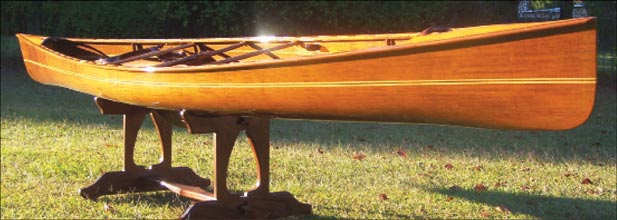
By Mark Shaffer
Photos Courtesy of Phillip Greene
As a child growing up in the wilds of the Northern Adirondacks in upper New York state, Phillip Greene’s first passion was fishing and a canoe was simply “a way to get to where the fish are; a mode of transportation.” With time this opinion has evolved. Today Greene’s meticulously handcrafted canoes and paddles are commissioned and collected as pieces of fine functional art.
In fact “meticulous” doesn’t begin to approach the process. Each of Greene’s Wood Song Canoes is another chapter in the artist’s relentless pursuit of perfection. Let me put it this way: even if you can afford one of Greene’s canoes, chances are it’s never going near the water. With a starting price of $70,000 a Wood Song Canoe rarely gets wet. “I can’t afford to paddle the canoes I make anymore,” says the artist with a laugh.
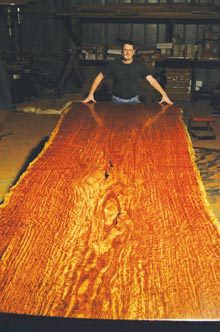 Phil Greene’s canoes may be boats when all is said and done, but they have more in common with fine sculpture than with rudimentary watercraft. To call Greene a boat maker is like saying Michelangelo was the guy to call if you needed a ceiling painted. Saturday April 12, Greene is the featured artist at the second annual Artisans & Antiques event at Habersham. I spoke to him by phone from his home in Round O, near Walterboro, where he also teaches the art of crafting his fine canoes.
Phil Greene’s canoes may be boats when all is said and done, but they have more in common with fine sculpture than with rudimentary watercraft. To call Greene a boat maker is like saying Michelangelo was the guy to call if you needed a ceiling painted. Saturday April 12, Greene is the featured artist at the second annual Artisans & Antiques event at Habersham. I spoke to him by phone from his home in Round O, near Walterboro, where he also teaches the art of crafting his fine canoes.
Mark Shaffer: So what do you paddle these days?
Phillip Greene: I paddle the cheapest canoes on the market, around $500 brand new. They have a decent shape and shape is everything when it comes to canoes. Shape dictates how it performs in the water and these work fine. Now, the ones I make are much better, but I can’t afford to paddle them.
MS: That is an artistic irony.
PG: (Laughs) It is, indeed. But I do use my own paddles.
MS: You are essentially self-taught, right?
PG: I am self-taught. I read a book in 1987 when I was on submarines. Out in the middle of the North Atlantic in wintertime is pretty boring for a sonarman so on my off time I’d read the book cover-to-cover on how to build wood strip canoes. I came home in ’88 and started my first one and that took something like seven or eight months. After the first one I threw the book out because they didn’t know what they were talking about (laughs). I did a lot of research and development on my own after that.
MS: So you attended the academy of trial and error?
PG: Yes, a lot of trial and error. I’ve always taught my students that if you can’t critique yourself  harshly you’ll never improve. You have to bite the “pride” bullet and say ‘all right, we’re done with this project. Now, let’s go over it with a fine tooth comb and see what’s wrong with it, determine what caused it and figure out how to avoid doing that again.’
harshly you’ll never improve. You have to bite the “pride” bullet and say ‘all right, we’re done with this project. Now, let’s go over it with a fine tooth comb and see what’s wrong with it, determine what caused it and figure out how to avoid doing that again.’
MS: I love a quote you have on your website: “In order to achieve perfection, an artist must be willing to scrutinize and criticize their own best work, even if others can find no fault.”
PG: That’s exactly right. My wife says I “chase rabbits.” Forgive me if I do. But I’m always thinking ahead and I have a tendency to spend a lot of time on [fine details].
MS: This brings up a good point. There is an undefined line between craftsmanship and art—
PG: Yeah!
MS: Did you start out to make boats or did you start out to make art?
PG: Started out to make boats.
MS: At what point did you realize you’d progressed past the point of being a craftsman looking to make a decent boat to get to the fish?
PG: I get asked about this a lot. An artist and an artisan are slightly different. An artist makes something that’s basically non-useful. In other words, you can hang a painting on the wall but it doesn’t do anything. But an artisan is a step above a construction guy who’s making something that’s purely functional. The artisan kind of falls between pure construction and the artist. Maybe something in that “functional” item isn’t really functional.
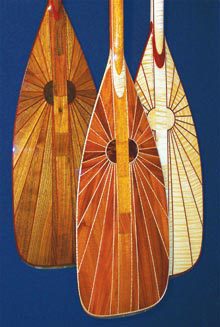 The first canoe I built that fit that criteria was out of ebony, an African wood that’s all black and can’t really take the sun. It’s extremely heavy and is strictly a museum piece of sculpture. Will it actually float? Yes. If you took it out on a cloudy day you’d be fine. The problem is that when the sun hits it, it heats up so fast that it would [compromise the structure]. Functionally, it’s not a good boat. But it is so gorgeous to look at.
The first canoe I built that fit that criteria was out of ebony, an African wood that’s all black and can’t really take the sun. It’s extremely heavy and is strictly a museum piece of sculpture. Will it actually float? Yes. If you took it out on a cloudy day you’d be fine. The problem is that when the sun hits it, it heats up so fast that it would [compromise the structure]. Functionally, it’s not a good boat. But it is so gorgeous to look at.
MS: These boats are incredibly time-consuming and complicated to build, serious commitments.
PG: I know a guy in northern New York State in the Adirondacks where I grew up who builds a canoe a week and they’re the same type as mine, they’re just much simpler. He’s not spending nearly as much time on perfection, but he builds one in 40 to 60 hours. I think the fastest I could get one done would be somewhere between 700 to 800 hours. And most of them come in at 1000 to 1200 hours. I’ve done two of the ebony canoes and those took 2000 hours a piece to build.
MS: Wow.
PG: Yes, that’s a whole year. But I get paid well for them.
MS: Well, yeah. You mentioned you can’t afford to paddle your own canoes and here’s why: they’re not cheap.
PG: They start at around $70,000 and I’ve sold them as high as $155,000.
MS: And let us not forget the paddles. They are absolutely beautiful.
PG: I’m working on some right now for the Beaufort show. I’m glad this happened. It’s forcing me to 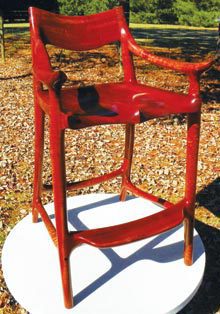 get them finished. I’m actually going to bring one of the high-end bar stools that I built for a billionaire in Connecticut. They’re about $15,000 each. People at the show will be just as interested in the barstools as the canoes. They’ve never seen a barstool like this.
get them finished. I’m actually going to bring one of the high-end bar stools that I built for a billionaire in Connecticut. They’re about $15,000 each. People at the show will be just as interested in the barstools as the canoes. They’ve never seen a barstool like this.
MS: I’ve spent a lot of time on barstools and I’m pretty sure I’ve no idea what a $15,000 barstool sits like much less looks like.
PG: (Laughs) I spent 13 years in the Navy and I was always the designated driver, the non-drinker. So I hadn’t really sat on a lot of barstools before. So when this guy asked me to build them for him it was quite an ordeal just getting the design right.
MS: You’re bringing a canoe to Habersham, one that’s usually on display at the South Carolina Artisan’s Center in Walterboro.
PG: It belongs to a guy in Walterboro and I’ve got to ask him if I can borrow it, but I don’t see a problem. I’ve borrowed it before.
MS: This is a boat with a history too complicated to go into here, but for whatever reasons you consider this a “second.” It was a work in progress that went on and on and on. I’ve seen it up close and it’s a breathtaking piece of work.
PG: It’s got quite a history. And I hate that I don’t have a perfect boat to take to the show, but I don’t. Most people are going to love it anyway.
MS: Even though you consider it a second, it’s still going to be the most beautiful canoe most people will ever see.
PG: Right.
MS: You teach and offer apprenticeships. Are you seeing a healthy interest in keeping this art form alive?
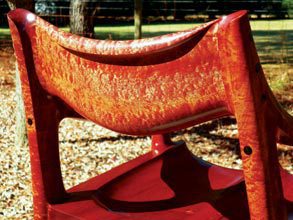 PG: I do when I’ve had a bunch of magazine articles out and I simply haven’t in the last few years. My business is built on my ability to go to national, sometimes international magazines, give them the story and say “it’s there if you want it.” I’ve been shocked at how many of them have taken me up on the offer and run the story. When that happens I get interest. Locally, I don’t have too many people who are interested. Canoeing is not a South Carolina thing nowadays. It’s more of a northern thing. Kayaking has taken off on the coastal areas and I do build kayak paddles but I’ve never built a kayak. I will build kayaks if somebody wants me to.
PG: I do when I’ve had a bunch of magazine articles out and I simply haven’t in the last few years. My business is built on my ability to go to national, sometimes international magazines, give them the story and say “it’s there if you want it.” I’ve been shocked at how many of them have taken me up on the offer and run the story. When that happens I get interest. Locally, I don’t have too many people who are interested. Canoeing is not a South Carolina thing nowadays. It’s more of a northern thing. Kayaking has taken off on the coastal areas and I do build kayak paddles but I’ve never built a kayak. I will build kayaks if somebody wants me to.
MS: Would those be functional?
PG: Oh yeah, fully functional. I’d design the thing myself.
Learn more about Phillip Greene’s canoes and his apprenticeship program online at www.woodsongcanoes.com
Wood Song Canoes
425 Jessie Lane
Round O, South Carolina 29474
(843) 835-8137







